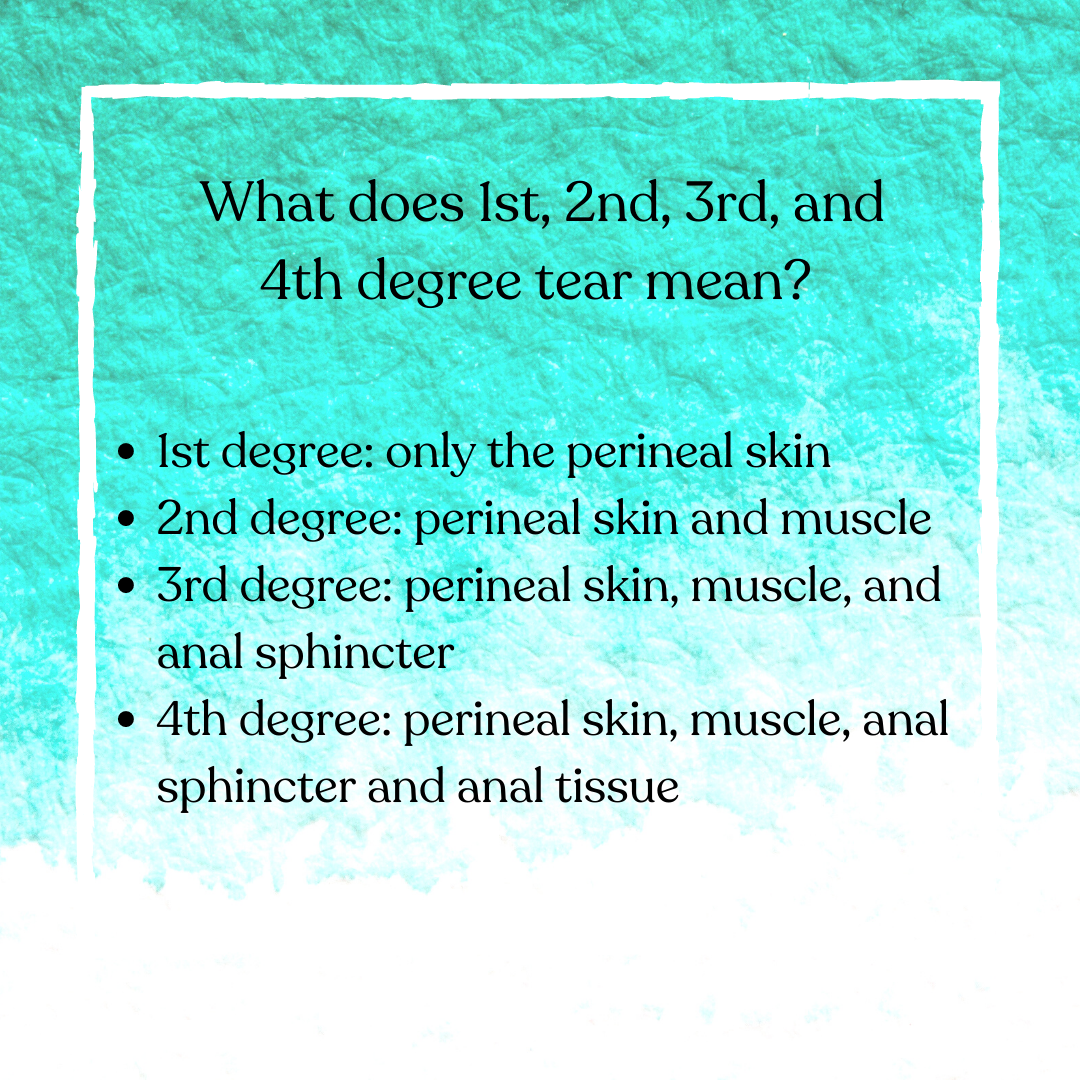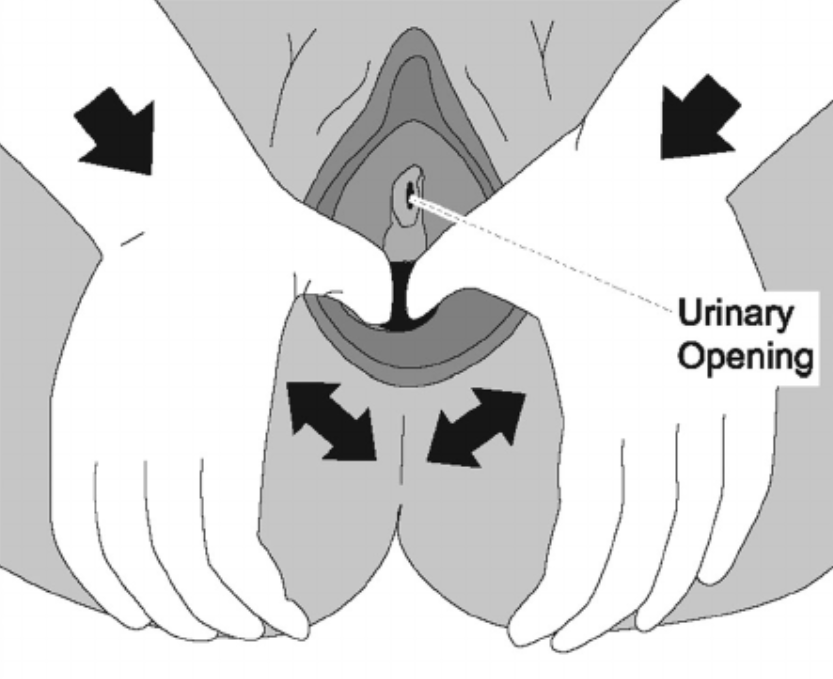Perineal stretching during pregnancy: does this help prevent tearing with vaginal birth?
What exactly is “perineal stretching”?
Ok, let’s start at the beginning. You may be wondering “what the heck is perineal stretching?” Well, first let’s review what the perineum is. This is an area of skin/muscle/fascia between the vaginal opening (for people with a uterus) and anal opening. In middle school, not a place flush with maturity, I believe this area was referred to as the “taint”, but it’s really the perineum. This area stretches when giving birth vaginally and sometimes the perineum or vagina will tear.
So, perineal stretching/massage is a manual technique that a pregnant person or partner can perform on a regular basis, toward the end of pregnancy, in an attempt to stretch the skin and muscle in order to better prepare the tissues for the stretching that happens during vaginal childbirth.
Is there evidence that this is helpful or just wishful thinking?
When looking for evidence, it is important to have common reference points. That way, we’re all speaking the same language when comparing one study outcome to another. So when talking about perineal tearing or trauma, medical providers use “degrees” to define what we are talking about.
What symptoms would someone have after having a tear with or without repair with stitches? Mild pain, stinging with urination, and possible pain with sexual activity involving vaginal penetration. Fecal and/or flatulence incontinence and a longer healing time are associated with 3rd and 4th-degree tears.
Of note: while some tearing is common with vaginal birth, only 3-7% have 3rd or 4th degree tearing with spontaneous vaginal births.
Are there factors that make tearing more likely to happen?
First-time vaginal birth
Delivery with forceps assistance
Delivery with vacuum assistance
An episiotomy is performed
Advanced maternal age
Induction of labor
Increased gestational age
Increased fundal pressure
Occipitoposterior delivery (baby is face-up)
Increased baby birth weight
Nationality
So, can perineal stretching during pregnancy be helpful?
Many studies have looked at the benefits of perineal massage performed during pregnancy. This systematic review by Abdelhakim et al in 2020 (see left) of previous randomized controlled trials, showed significantly decreased risk of perineal trauma and postpartum complications.
Rates of perineal tears, particularly 3rd and 4th-degree tears, and episiotomies were lower.
The massage groups overall had better wound healing and decreased levels of perineal pain postpartum.
Most of these benefits were significant only for those who did perineal stretching/massage prior to first-time vaginal births. However, one study did show a 32% decreased risk of on-going perineal pain 3 months postpartum, for those who did perineal stretching/massage during pregnancy after having given birth in the past.
Great! What’s the best way to stretch the perineum and vaginal opening?
Start with washing your hands and find a place where you can relax and be comfortable with your legs open and knees bent. You can be semi-reclined in your bed or a bathtub. If this is too difficult based on belly size, you can stand, prop one foot up on a chair with your knee out to the side (Captain Morgan position) to try to get better access. You can also try using a pelvic wand or have your partner help if you find it challenging.
Lubricate your thumb (or finger) and perineal tissue. You can use a quality water-based lubricant (Sliquid, Slippery Stuff, Good Clean Love, etc.), silicone-based (Uberlube), or oil, such as coconut or jojoba.
Insert your thumb or finger slightly inside the vaginal opening. Start shallow - putting pressure with the top of your thumb or finger pad. Push down (toward the anus) until you feel a stretch and slight discomfort. Hold for 3-4 slow, long breaths, imagining your pelvic floor muscles relaxing as you breathe and stretch. Repeat this at different points along the bottom half of the vaginal opening (if you think of the opening as a clock, this would be from 3 to 9 o’clock).
Repeat this process slightly deeper: middle to lower thumb or finger pad depth
Try some finger sweeps: put pressure toward one side and sweep down as you maintain pressure. Repeat with deep breathing 3-4x and then do the same on the other side.
If tolerated, consider a 2-thumb stretch as seen in the picture. This is a mild stretch and should not be painful. Do this for 3-4 breaths.
Focus on keeping the pelvic floor muscles relaxed and deep, slow breathing.
If your partner is helping with this, be sure to communicate to avoid too much pain or burning.
Permission to use copyright image from Pelvic Guru, LLC pelvicguru.com
When and how often?
Most studies that showed benefits looked at using massage techniques starting at 34-35 weeks of pregnancy for a duration of 5-10 minutes. Although results comparing frequency varied, stretching for 5-7 days/week appears to be the best strategy.
Are you currently pregnant and want to learn about optimizing your body during pregnancy and delivery? If you live in the greater Minneapolis, Minnesota area, my clinic is in Edina, MN. Let’s work together to create an action plan to overcome your pelvic health issues and reach your goals. Let’s work together - contact me to learn more!
Sources:
Abedzadeh-Kalahroudi M, Talebian A, Sadat Z, Mesdaghinia E. Perineal trauma: incidence and its risk factors. J Obstest Gynaecol. 2019 Feb;39(2):206-211.
Abdelhakim AM, Eldesauky E, Elmagd IA, Mohammed A, Farag EA, et al. Antenatal perineal massage benefits in reducing perineal trauma and postpartum morbidities: a systematic review and meta-analysis of randomized controlled trials. Int Urogynecol J. 2020 Sept;31(9):1735-1745.
Beckmann MM, Garrett AJ. Antenatal perineal massage for reducing perineal trauma. Cochrane Database Syst Rev. 2006 Jan;25(1): CD005123.
Hauck YL, Lewis L, Nathan EA, White C, Doherty DA. Risk factors for severe perineal trauma during vaginal childbirth: A Western Australia Retrospective Cohort Study. Women Birth. 2015 Mar;28(1):16-20.
Labrecque M, Eason E, Marcoux S, Lemieux F, Pinault J J, Feldman P, Laperriere L. Randomized controlled trial of prevention of perineal trauma by perineal massage during pregnancy. Am J Obstest Gynecol. 1999 Mar;180(3 pt 1) 593-600.
Perineal Massage in Pregnancy. J Midwifery Womens Health. 2016 Jan/Feb;61(1): 143-144.
Ugwu EO, Iferikigwe ES, Obi SN, Eleje GU, Ozumba BC. Effectiveness of antenatal perineal massage in reducing perineal trauma and postpartum morbidities: A Randomized Control Trial. J Obstet Gynaecol Res. 2018 July;44(7):1252-1258.
Weronika M, Weronika P, Kolomanska-Bogucka D, et al. Antenatal perineal massage - risk of perineal injuries, pain, urinary incontinence and dyspareunia - a systematic review. J Gynecol Obstet Hum Reprod. 2023 Oct;52(8):102627.
Disclaimer: These self-care suggestions are for general use only and are not intended to be used as medical advice, diagnosis, or treatment. Refer to your medical provider for all questions and concerns regarding your individual care.
Did you enjoy this post? Whether you're a newbie or a pelvic pro, join the community to stay up to date with the latest and greatest in pelvic health!







